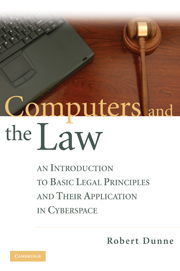Book contents
- Frontmatter
- Contents
- PREFACE
- ACKNOWLEDGMENTS
- 1 THE COMMON LAW AND STATUTORY LAW
- 2 CONTRACTS
- 3 TORTS INTRODUCTION
- 4 DEFAMATION
- 5 THIRD PARTY LIABILITY
- 6 COPYRIGHTS
- 7 TRADE SECRETS
- 8 TRADEMARKS
- 9 THE RIGHT OF PRIVACY
- 10 E-MAIL
- 11 THE RIGHT OF PUBLICITY
- 12 CONSTITUTIONAL LAW
- 13 PORNOGRAPHY AND OBSCENITY
- 14 ADVERTISING AND SPAM
- 15 JURISDICTION
- AFTERWORD
- INDEX
3 - TORTS INTRODUCTION
Published online by Cambridge University Press: 05 June 2012
- Frontmatter
- Contents
- PREFACE
- ACKNOWLEDGMENTS
- 1 THE COMMON LAW AND STATUTORY LAW
- 2 CONTRACTS
- 3 TORTS INTRODUCTION
- 4 DEFAMATION
- 5 THIRD PARTY LIABILITY
- 6 COPYRIGHTS
- 7 TRADE SECRETS
- 8 TRADEMARKS
- 9 THE RIGHT OF PRIVACY
- 10 E-MAIL
- 11 THE RIGHT OF PUBLICITY
- 12 CONSTITUTIONAL LAW
- 13 PORNOGRAPHY AND OBSCENITY
- 14 ADVERTISING AND SPAM
- 15 JURISDICTION
- AFTERWORD
- INDEX
Summary
Definition
This chapter provides a broad background about torts as well as about the elements of a number of specific torts. Some torts may seem unlikely to apply in cyberspace – and they may not – but that is what was once thought regarding the tort of “trespass to chattels,” which was ultimately used quite creatively as a tool of cyberlaw.
In their famous legal treatise on torts, Prosser and Keeton wrote, “Broadly speaking, a tort is a civil wrong, other than breach of contract, for which the court will provide a remedy in the form of an action for damages.” So note that torts are civil wrongs, as opposed to criminal wrongs. No one goes to jail for committing a tort, although the same behavior that resulted in a civil tort suit may separately also be the basis for a criminal action. For example, if person A stabs and kills person B, person A may be convicted of the crime of murder and be punished accordingly. However, person A may separately be found liable to the estate of person B in a civil suit for the tort of wrongful death, and have to pay damages to the estate.
The fundamental issue of torts is whether and when losses should be shifted from the victim of an injury to the person who inflicted the injury or some other source of compensation – often an insurance company.
- Type
- Chapter
- Information
- Computers and the LawAn Introduction to Basic Legal Principles and Their Application in Cyberspace, pp. 57 - 66Publisher: Cambridge University PressPrint publication year: 2009



